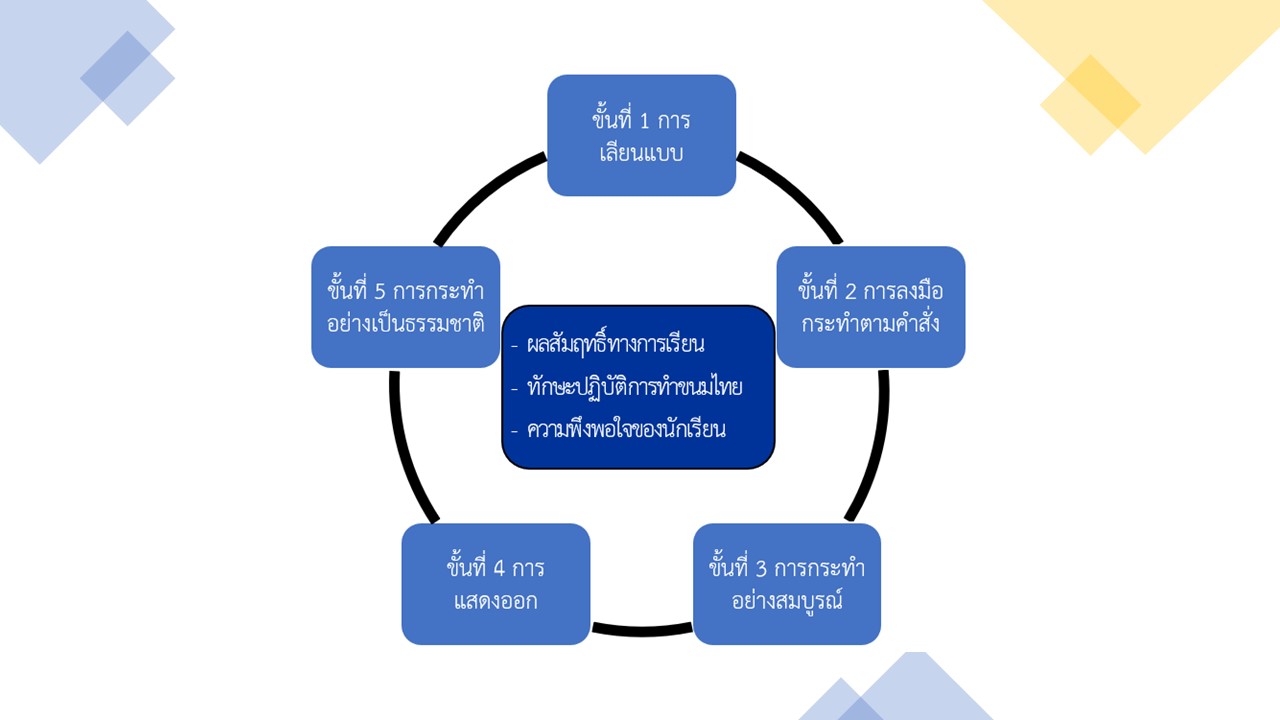การจัดการเรียนรู้โดยใช้รูปแบบการสอนทักษะปฏิบัติของแฮร์โรว์ที่มีต่อผลสัมฤทธิ์ทางการเรียนและทักษะปฏิบัติการทำขนมไทยของนักเรียนชั้นมัธยมศึกษาปีที่ 2
Main Article Content
บทคัดย่อ
การวิจัยครั้งนี้มีวัตถุประสงค์ 1) เพื่อเปรียบเทียบผลสัมฤทธิ์ทางการเรียนกลุ่มสาระการเรียนรู้การงานอาชีพของนักเรียนชั้นมัธยมศึกษาปีที่ 2 ก่อนและหลังการจัดการเรียนรู้โดยใช้รูปแบบการสอนทักษะปฏิบัติของแฮร์โรว์ 2) เพื่อเปรียบเทียบทักษะปฏิบัติการทำขนมไทยของนักเรียนชั้นมัธยมศึกษาปีที่ 2 หลังการจัดการเรียนรู้โดยใช้รูปแบบการสอนทักษะปฏิบัติของแฮร์โรว์กับเกณฑ์ร้อยละ 80 และ3) เพื่อศึกษาความพึงพอใจของนักเรียนต่อการจัดการเรียนรู้โดยใช้รูปแบบการสอนทักษะปฏิบัติของแฮร์โรว์ กลุ่มตัวอย่างที่ใช้วิจัยครั้งนี้คือ นักเรียนชั้นมัธยมศึกษาปีที่ 2 สังกัดสำนักงานเขตพื้นที่การศึกษาประถมศึกษาสงขลา เขต 2 ภาคเรียนที่ 2 ปีการศึกษา 2566 จำนวน 28 คน เครื่องมือที่ใช้ในการวิจัยประกอบด้วย 1) แผนการจัดการเรียนรู้โดยใช้รูปแบบการสอนทักษะปฏิบัติของแฮร์โรว์ เรื่อง ทักษะปฏิบัติขนมไทย จำนวน 5 แผน 2) แบบทดสอบวัดผลสัมฤทธิ์ทางการเรียน เรื่อง ทักษะปฏิบัติขนมไทย 3) แบบวัดทักษะปฏิบัติขนมไทย และ4) แบบประเมินความพึงพอใจ วิเคราะห์ข้อมูลโดยใช้ค่าเฉลี่ยส่วนเบี่ยงเบนมาตรฐานและการทดสอบที ผลการวิจัยพบว่า 1) ผลสัมฤทธิ์ทางการเรียนกลุ่มสาระการเรียนรู้การงานอาชีพ ของนักเรียนชั้นมัธยมศึกษาปีที่ 2 หลังการจัดการเรียนรู้โดยใช้รูปแบบการสอนทักษะปฏิบัติของแฮร์โรว์สูงกว่าก่อนการจัดการเรียนรู้อย่างมีนัยสำคัญทางสถิติที่ระดับ .05 2) ทักษะปฏิบัติการทำขนมไทยของนักเรียนชั้นมัธยมศึกษาปีที่ 2 หลังการจัดการเรียนรู้โดยใช้รูปแบบการสอนทักษะปฏิบัติของแฮร์โรว์ สูงกว่าเกณฑ์ร้อยละ 80 อย่างมีนัยสำคัญทางสถิติที่ระดับ .05 และ3) ความพึงพอใจของนักเรียนชั้นมัธยมศึกษาปีที่ 2 ต่อการจัดการเรียนรู้โดยใช้รูปแบบการสอนทักษะปฏิบัติของแฮร์โรว์ อยู่ในระดับมากที่สุด
Article Details
เอกสารอ้างอิง
กิติพงษ์ แหน่งสกูล (2557). การพัฒนาผลสัมฤทธิ์ทางการเรียนและทักษะการปฏิบัติงาน เรื่อง การใช้โปรแกรมประมวลผลคำ กลุ่มสาระการเรียนรู้การงานอาชีพและเทคโนโลยีของนักเรียนชั้นประถมศึกษาปีที่ 6 โดยใช้วิธีสอนแบบชี้แนะร่วมกับรูปแบบการเรียนการสอนทักษะปฏิบัติของแฮร์โรว์. วิทยานิพนธ์ ศึกษาศาสตรมหาบัณฑิต สาขาวิชาหลักสูตรและการสอน. มหาวิทยาลัยหาดใหญ่.
กระทรวงศึกษาธิการ. (2551). หลักสูตรแกนกลางการศึกษาขั้นพื้นฐานพุทธศักราช 2551. กรุงเทพฯ: ชุมนุมสหกรณ์การเกษตรแห่งประเทศไทย.
ชัยวัฒน์ สุทธิรัตน์. (2559). 80 นวัตกรรมการจัดการเรียนรู้ที่เน้นผู้เรียนเป็นสำคัญ. พิมพ์ครั้งที่. นนทบุรี: พีบาลานซ์ดีไซด์แอนปริ้นติ้ง.
ทิศนา แขมมณี. (2560). ศาสตร์การสอน: องค์ความรู้ เพื่อการจัดกระบวนการเรียนรู้ที่มีประสิทธิภาพ. พิมพ์ครั้งที่ 7. กรุงเทพฯ: สำนักพิมพ์แห่งจุฬาลงกรณ์มหาวิทยาลัย.
นรนิติ พรหมพื้น. (2560). การพัฒนาทักษะการเขียนแบบเบื้องต้น ด้วยรูปแบบการสอนทักษะปฏิบัติของแฮร์โรว์ สำหรับนักเรียนชั้นมัธยมศึกษาปีที่ 6 โรงเรียนสวนกุหลาบวิทยาลัย. นนทบุรี. การประชุมเสนอผลงานวิจัยระดับชาติ มหาวิทยาลัยสุโขทัยธรรมาธิราช ครั้งที่ 10. 34-45.
บุญชม ศรีสะอาด. (2559). การวิจัยเบื้องตน. กรุงเทพฯ: สุริยาสาส์น.
บุษยพงศ์ มุสิกไชย. (2553). การศึกษาเฉพาะบุคคลเป็นส่วนหนึ่งของการศึกษาตามหลักสูตร. บริหารธุรกิจมหาบัณฑิต. มหาวิทยาลัยกรุงเทพ.
ศรัณย์พร พูนสมบัติ. (2561). การพัฒนาเอกสารประกอบการเรียนโดยใช้กระบวนการเรียนรู้แบบเบรนเบสต์ เพื่อพัฒนางานปั้นตามจินตนาการ สำหรับนักเรียนชั้นประถมศึกษาปีที่ 6. งานวิจัยโรงเรียนเทศบาลบ้านคูหาสวรรค์.
สุมิตรา อุ่นเปีย. (2557). ผลการจัดกิจกรรมศิลปะตามแนวคิดของแฮร์โรว์ที่มีต่อความสามารถในการปั้นของเด็กอายุ 9-11 ปี. วารสารอิเล็กทรอนิกส์ทางการศึกษา จุฬาลงกรณ์มหาวิทยาลัย. 9(1), 458-472.
สมเกียรติ จูรอด. (2564). การจัดการเรียนรู้กับทักษะที่จำเป็นสำหรับผู้เรียนในศตวรรษที่ 21. วารสารภาวนาสารปริทัศน์. 1(1), 25-36.
Davies, I. K. (1971). The Management of Learning. London: McGraw-Hill.
Harrow, A. (1972). A taxonomy of psychomotor domain: a guide for developing behavioral objectives. New York: David McKay.
Maslow, A. H. (1970). Motivation and Personality. New York: Harper and Row.


